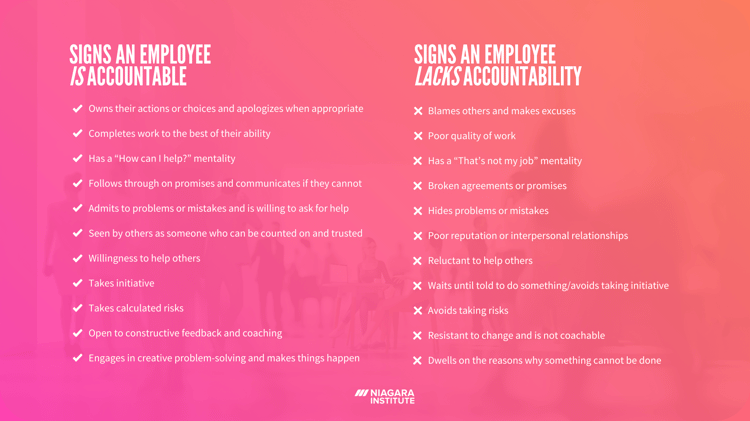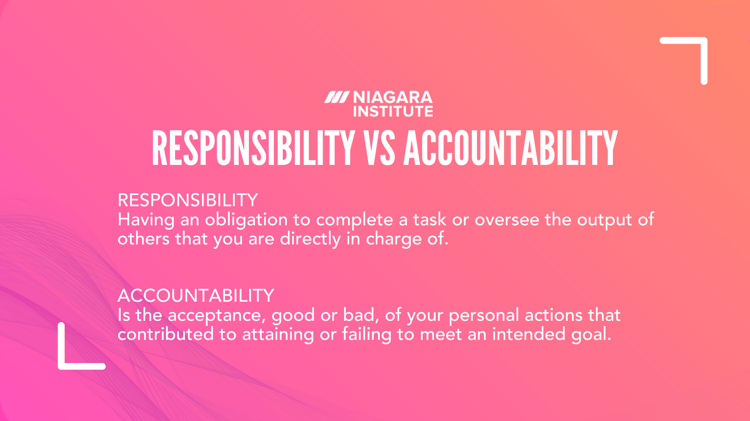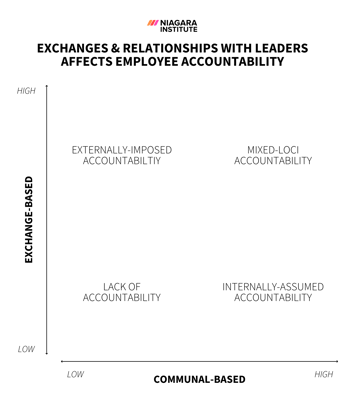How To Hold Employees Accountable:
A Leader’s Guide to Accountability in the Workplace
Accountability in the workplace is a challenge many leaders face, as 25% report an absence of accountability as the biggest hurdle for leading their team. This begs the question: How can leaders drive accountability in a way that doesn’t feel like punishment, but in a way that is truly motivating. To get answers to those questions and more, you'll want to read the following guide.
Download the PDF (English & French Included)
Introduction
An accountable employee makes a promise and follows it through, takes responsibility for their actions (good or bad!), owns their mistakes, and takes initiative without being told. They’re someone every leader wants to have on their team.
In reality, though, 25% of managers report a lack of accountability as the biggest hurdle for leading their team. Which begs the question: how can you change this? How do you hold people accountable? Not in a way that feels forced or like a punishment, but in a way that feels authentic and truly motivating for the employee.
While there are things employees can (and should) be doing to take accountability in the workplace, it’s important to note that in a study of 40,000 professionals, 84% cited that the way their leaders behave is the single most important factor influencing accountability.
This is to say that if you want to improve accountability amongst your team, then it must be a joint effort between yourself and the individuals in your charge.
In the following guide, we’ll outline what it looks like to be accountable vs. lacking accountability, the difference between responsibility and accountability, the factors influencing an employee’s willingness to take accountability, and practical tips for creating a culture of accountability on your team. Let’s get started.
What Is Accountability In The Workplace and How to Spot It
An accountable employee makes a promise and follows it through, takes responsibility for their actions (good or bad!), owns their mistakes, and takes initiative without being told. They’re someone every leader wants to have on their team.
By definition, accountability is the acceptance of responsibility for your actions and choices that lead to an outcome, whether it is good or bad. Someone who is highly accountable admits their mistakes, keeps their promises, communicates openly, is willing to help others, and takes initiative when appropriate.
To help you spot individuals on your team who are accountable, as well as those who may be lacking accountability, we’ve outlined several common signs of each below.

Signs an Employee Is Accountable
-
Owns their actions or choices and apologizes when appropriate
-
Completes work to the best of their ability
-
Has a “How can I help?” mentality
-
Follows through on agreements or promises and communicates if they cannot
-
Admits to problems or mistakes and is willing to ask for help
-
Seen by others as someone who can be counted on and trusted
-
Willingness to help others
-
Takes initiative
-
Takes calculated risks
-
Open to constructive feedback and coaching
-
Engages in creative problem-solving and makes things happen
Signs an Employee Lacks Accountability
-
Blames others and makes excuses
-
Poor quality of work
-
Has a “That’s not my job” mentality
-
Broken agreements or promises
-
Hides problems or mistakes
-
Poor reputation or interpersonal relationships
-
Reluctant to help others
-
Waits until told to do something/avoids taking initiative
-
Avoids taking risks
-
Resistant to change and is not coachable
-
Dwells on the reasons why something cannot be done
What’s the Difference Between Responsibility and Accountability?
If you think the terms responsibility and accountability are interchangeable, think again. There is a slight but significant distinction between the two.

The difference between responsibility and accountability lies in the ownership of the result. Responsibility is the obligation to complete a task or duty. In contrast, accountability is completing the assignment or duty AND accepting ownership of the outcome, whether it is a positive or negative result. There are no excuses, blame, or justification for results when an individual is accountable. They take personal ownership of their actions, attitudes, behaviors, and results.
For example, an employee is responsible for ensuring the VP of Sales presentation deck is free of errors, is updated for their client presentation, and printed copies of the deck are ready for when they leave. However, in preparing the presentation for the next day, their computer crashes. Instead of proclaiming, “I could not get your presentation completed because my computer crashed,” they borrow a colleague's computer and stay late to ensure the VP of Sales has everything they need for the following day.
In essence, accountability is ensuring their responsibilities are met, no matter the roadblock faced. However, building a team of accountable employees requires creating the right environment and conditions so accountability can thrive. We’ll discuss that in more detail in the following sections.
Get Your PDF
Save This For Later
After filling out the form, we will send you to the PDF version and also a copy to your email so you can file it away or share it with your colleagues.
What Factors Influence Accountability?
You want your employees to be accountable. That’s the goal. The path to getting there though can be complicated. Everything from your employee’s career goals to their past experiences, their level of ambition or motivation, their interest in the work at hand, and their sense of purpose can influence their willingness to take accountability at work. Not to mention, external conditions and factors, such as the company or team culture, leadership, and company values, can further influence this, for better or worse.
While these factors may complicate matters, there are things you can do as a leader to positively influence an employee’s willingness to take accountability.

For example, in 2019 the Organizational Psychology Review found that the type of exchanges and relationships employees have with their leaders influences their level of accountability.
When a leader’s exchanges and relationships with employees are communal-based it means they respond to their employee's needs without expecting specific returns or immediate reciprocity, are concerned with others’ benefits, and are motivated to enhance the welfare of others. Whereas leaders with exchange-based relationships focus on reciprocity and treat employees’ welfare or emotional needs as secondary. In other words, they give something with the expectation that they will get something in return.
As you might suspect, employees whose exchanges and relationships were more communal-based and less exchange-based, experienced higher levels of accountability.
Internally-Assumed Accountability: This is the highest level of accountability and is achieved when employees interact with others who genuinely care and want to help, and are not concerned with being “paid back” so to speak. The result is employees who have a strong sense of personal ownership, are empathetic, and are very willing to help or contribute as needed
Mixed-Loci Accountability: When employees experience both communal and exchange-based relationships with their leaders, they have a sense of ownership and are willing to help others, but they may also act upon their own interests and expect something in return for the help they give others.
Externally-Imposed Accountability: When employees' exchanges and relationships with leaders are mainly exchanged-based, employees are less likely to take ownership of their actions, admit mistakes, or go out of their way to help others.
Lack of Accountability: Under leaders who take a laissez-faire approach, set few expectations, and inadequately address performance issues, employees may lack accountability, avoid helping others in solving problems, take little or no ownership of mistakes, and offer vague explanations regarding their poor performance or mistake.
.png?width=1920&name=What%20Factors%20Influence%20Accountability%20(1).png)
6 Ways to Create a Culture of Accountability in Your Team
For accountability to thrive, it cannot lie within a few individuals on your team. It must span everyone, and be the way things are done on the team, otherwise known as a team’s culture. As you can imagine, if everyone does not demonstrate accountability on the team, those who do will resent going the extra mile when those around them don’t. So how do you build a team environment where the culture is one in which everyone is accountable? Here are six ways to do so.
Demonstrate Accountability in Leadership
An accountable team starts with you - the leader. Accountability will not thrive if there is no accountability in leadership. Employees look to their leader to understand how they should behave, what is acceptable, and for cues on the team's norms. If you’re not demonstrating accountability, they will not either. No amount of coaching, training, or discussions will help.
To demonstrate accountability to your employees, you’ll need to:
-
Ensure your commitments are actioned
-
Follow through on promises
-
Give rationale and answer to your decisions and actions
-
Have clear goals and targets that can measure your success
-
Communicate a team vision of what you’re trying to achieve
-
Answer questions and provide clarity on your plan for the team to achieve their goals
-
Be honest and demonstrate humility by asking for help and input from others
Being an accountable leader isn’t always easy. However, demonstrating accountability in leadership fosters trust, collaboration, and the feeling that your actions are in the best interest of your employees and the organization. It makes those around you want to follow your lead and be accountable as well.
.png?width=1920&name=Accountability%20in%20leadership%20(1).png)
Define Goals and Expectations
For a team to be accountable, they have to understand what they’re trying to accomplish, accompanied by a shared understanding of the expected results, timelines, scope, resources, and roles and responsibilities. There should be no ambiguity on what success looks like. Clear goals and expectations are the foundation individuals will use to make decisions. It is critical goals and expectations are in place and are frequently communicated to reinforce the message.
After studying more than 31 million employees, Gallup recommends leaders do the following when establishing expectations with employees.
-
Collaborate on Expectations: Leaders need to get their team's input on expectations. In doing so, each individual and the collective team are much more likely to take ownership of their expectations and those of the team.
-
Clear Leadership Communication: Employees and the team shouldn’t be left to decipher what is expected. Leaders need to remove any guesswork by speaking with clarity when it comes to expectations and goals.
-
Move Beyond Mediocre: Employees are not inspired by meeting a minimum standard. Expectations and goals should be established with top performance in mind. In doing so, you’ll encourage employees to develop and grow to meet expectations.
-
Play to Individual Strengths: Every team is made up of people who have unique strengths and talents. Understanding what comes naturally to each individual and mapping those strengths to the team goal when establishing expectations and individual accountabilities will enhance both performance and engagement on the team.
Secure Commitment to Accountabilities
Hand in hand with clear goals and expectations are defined accountabilities and securing individual commitment. For a culture of accountability to take root, each individual must understand what is expected of them to be able to commit to achieving their accountabilities. In essence, commitment requires an employee to understand their role in what needs to be done and a willingness to do whatever it takes to achieve success.
Remember that owning results must be agreed upon - it cannot be forced. Forced accountability isn’t actually accountability. Accountability only truly exists when an individual takes personal ownership of their actions and results.
In addition to getting individual commitment, every employee must understand the roles and accountabilities of their teammates. Each team member needs to know what is expected of them, how their contributions impact the larger team goal, and their peers' accountabilities and roles. Without role clarity and team alignment on who is doing what, individuals will likely waste time and energy protecting tasks they believe are theirs and hoarding resources rather than focusing on what needs to be accomplished to achieve the team goal.
Encourage Empowerment with Boundaries
For accountability to thrive over the long run, individuals must be empowered to achieve their accountabilities as they see fit. However, empowerment needs boundaries. It cannot be a free for all where employees are empowered to make critical decisions, spend freely, or go outside company policies. Each employee's boundaries will vary based on their experience, track record, knowledge, and skill. You will need to clearly communicate what they can do without your input and when they need to get your approval.
Once you have granted autonomy, communicated boundaries, and secured commitment, be careful not to fall into the trap of inserting yourself and offering your unsolicited preferences and opinions though. This can swiftly derail your employee's progress and even discourage them from committing to accountability in the future.
.png?width=1920&name=Encourage%20Empowerment%20with%20Boundaries%20(1).png)
Ensure Failure is Not Criticized
If mistakes and missteps are criticized, reprimanded, or individuals feel ostracized for falling short, it will jeopardize any progress in building a team culture of accountability. Who would be willing to be accountable ever again if this happens?
When building a culture of accountability, the team dynamic needs to be a safe space where trust and integrity are common practices. Team members feel open to acknowledging mistakes and are willing to conduct a post-mortem meeting to reflect, learn, and ultimately move forward. In this type of environment, individuals are not focused on who dropped the ball or made an error, but where failure is seen as a learning opportunity to diagnose what went wrong and how it can be prevented from happening in the future.
Frequently Communicate and Offer Feedback
When building a team culture of accountability, it’s essential that you frequently communicate with and offer constructive feedback to your employees. Doing so helps ensure complete clarity regarding what you’re trying to achieve and the role everyone plays in doing so.
You can do this and reinforce each team member’s accountabilities by reviewing what is expected of them and giving them the tools, advice, knowledge, and confidence to live up to their expectations in your weekly team meetings and one-on-one meetings. During these meetings, make a point to check in on everyone’s progress, identify any roadblocks that you need to remove for them, and provide coaching, encouragement, and constructive feedback.
In addition to frequent communication and feedback from yourself, encourage your employees to provide you with feedback and to offer it to one another as peers. If the goal is to build a team culture of accountability where every member is committed to achieving the goal together, then constructive feedback will be treated and embraced as a way to propel the team forward, not as a way to knock each other down or get ahead of someone else.
The Next Steps
Like communication and delegation, the ability to hold employees accountable is a learnable leadership skill. Regardless of their level, experience, or title, any leader can learn what it takes to motivate their employees to take greater accountability in the workplace.
However, 82% of managers admit that they have “limited to no” ability to hold others accountable successfully and 91% of employees say that “effectively holding someone accountable” is one of their company’s top leadership development needs. Not to mention, it’s not just managers and supervisors who are struggling to hold others accountable. In Predictive Index’s 2019 CEO Benchmarking Report, holding people accountable was the number one weakness among the surveyed CEOs before creating a solid strategy, staying focused, and communicating effectively.
If you find yourself feeling similarly, the good news is that there is no better time to invest in your leadership development and learn the skills required to effectively hold employees accountable. Not to mention, with Niagara Institute, you have access to some of the best leadership development programs and professional leadership coaches so you can achieve your unique professional goals when you’re ready.
%20(2).png?width=1920&name=Accountability%20Training%20for%20Groups%20(1)%20(2).png)
Get Your PDF
Save This For Later
After filling out the form, we will send you to the PDF version and also a copy to your email so you can file it away or share it with your colleagues.

